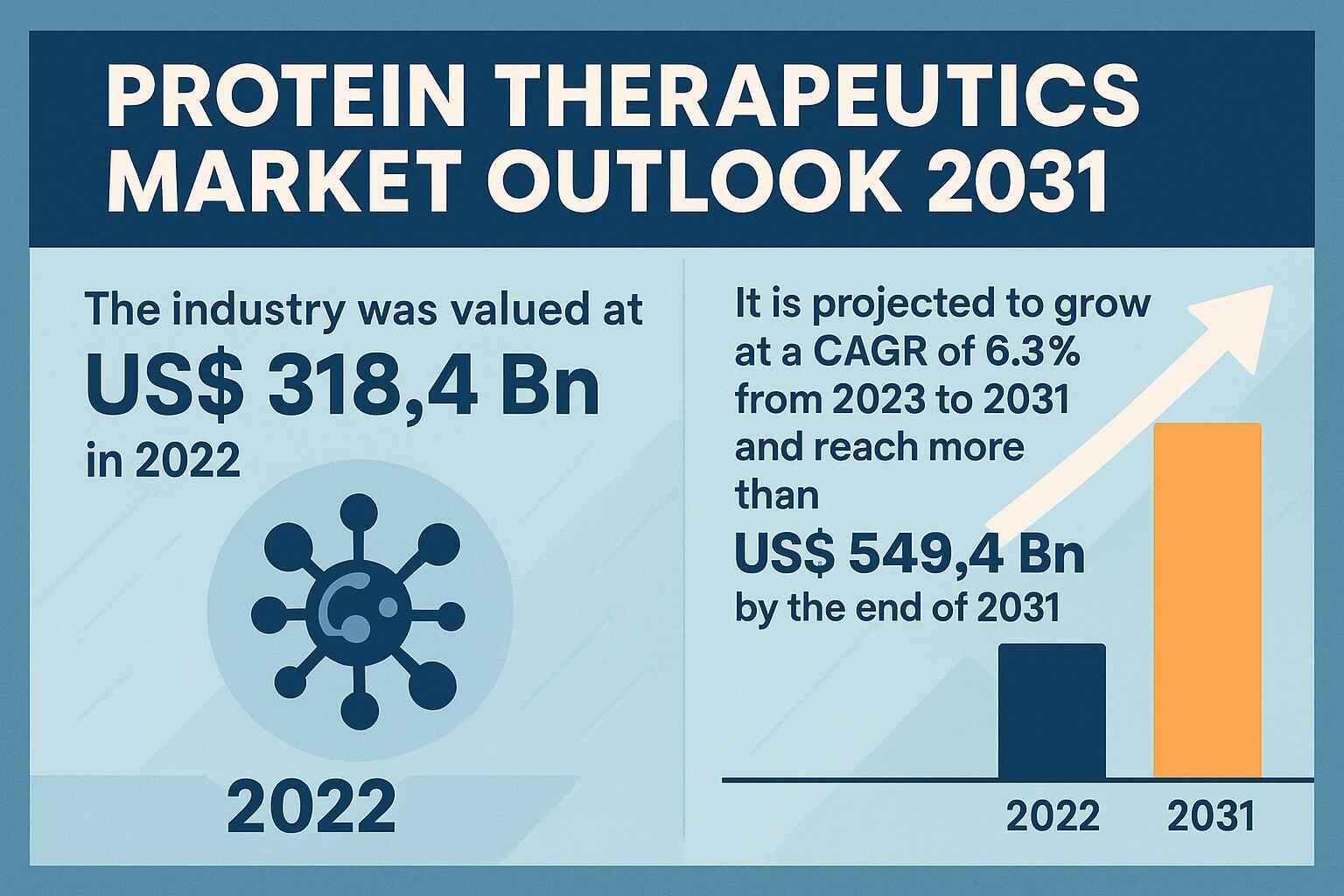Protein Therapeutics Market: Rising Biologics Innovation and Advanced Drug Delivery Systems Reshape Global Treatment Paradigms (2023–2031)

The Protein Therapeutics Market is experiencing unprecedented momentum as biologics become central to modern medical treatment across oncology, metabolic disorders, immunology, and genetic diseases. Estimated at US$ 318.4 Bn in 2022, the market is forecast to reach more than US$ 549.4 Bn by 2031, growing steadily at a CAGR of 6.3% through the forecast period.
Biologics Take Center Stage in Clinical Transformation
Protein therapeutics — including monoclonal antibodies, cytokines, hormones, enzyme replacement therapies, and fusion proteins — have moved from specialized use to mainstream treatment modalities. Their ability to act with high specificity at cellular and molecular levels makes them superior to many traditional drug categories.
This shift is driven by:
-
Expanding understanding of disease pathways
-
Ability to design proteins that mimic or regulate biological mechanisms
-
Growing preference for targeted over systemic therapies
Therapeutic proteins are especially critical in treating complex and chronic diseases where conventional therapies fall short.
Growing Prevalence of Chronic Disorders Fuels Market Expansion
The continuous rise in cancer, autoimmune disorders, hematological diseases, and metabolic conditions directly boosts demand for protein-based therapies. Monoclonal antibodies (mAbs) remain the most widely adopted therapeutic class due to:
-
High affinity binding to specific targets
-
Strong safety profile
-
Versatility across therapy areas
-
Ability to be engineered into bispecific or antibody-drug conjugate formats
Protein therapeutics continue to deliver improved outcomes, survival rates, and treatment personalization in chronic disease management.
Drug Delivery Innovations Enhance Therapeutic Efficacy
Advancements in formulation sciences and delivery systems have improved the pharmacokinetics, stability, and bioavailability of therapeutic proteins.
Key innovations include:
-
Long-acting injectable formulations reducing dosing frequency
-
Oral protein therapeutics emerging through breakthrough absorption technologies
-
Nanocarrier and nanoparticle-assisted delivery enhancing stability and targeted delivery
-
PEGylation and glycoengineering improving half-life and reducing immunogenicity
These advancements support global patient access, compliance, and clinical outcomes — making protein therapies more adaptable and commercially viable.
Biosimilars Revolutionize Market Accessibility
The expiration of patents for major biologics continues to spark significant growth in biosimilar development, enabling cost-effective access to protein therapeutics worldwide.
Benefits of biosimilar adoption include:
-
Reduced healthcare expenditure
-
Broader access in low- and middle-income regions
-
Healthy competition among manufacturers
-
Incentives for biologics innovation
With regulatory frameworks strengthening across both developed and emerging markets, biosimilars are positioned to drive the next wave of biologics adoption.
Cancer Remains the Dominant Application Segment
The cancer segment led the market in 2022 and will continue to dominate due to:
-
High global cancer incidence
-
Proliferation of antibody-drug conjugates (ADCs)
-
Expanding approvals of immune checkpoint inhibitors
-
Increased dependency on targeted antibody-based regimens
Oncology remains the most commercially significant field for protein therapeutics.
Regional Insights: North America Leads, Asia Pacific Accelerates
North America
-
Strong biotech ecosystem
-
Leading regulatory support for biologics
-
Innovation-driven companies and research centers
-
High adoption of mAbs, ERTs, and targeted proteins
Asia Pacific
-
Rapid expansion of biopharma manufacturing
-
Rising chronic disease prevalence
-
Accelerated investments in clinical research and biologics production
-
Growing patient awareness and affordability
Asia Pacific’s momentum positions it as the fastest-expanding region through 2031.
Competitive Strategies: Partnerships and M&A Fuel Innovation
Key companies shaping the market include:
Thermo Fisher Scientific, Sanofi/Genzyme, AbbVie, Takeda, Bayer, Amicus Therapeutics, Bristol-Myers Squibb, Daiichi Sankyo, Abbott, Leadiant Biosciences.
Important developments:
-
Thermo Fisher’s acquisition of PeproTech (2022) enhances recombinant protein capabilities
-
AbbVie–Plexium collaboration (2022) accelerates drug discovery in targeted protein degradation
Such strategic moves underscore the industry’s focus on R&D excellence, platform expansion, and next-generation protein modalities.
- AI
- Vitamins
- Health
- Admin/office jobs
- News
- Art
- Causes
- Crafts
- Dance
- Drinks
- Film
- Fitness
- Food
- Spellen
- Gardening
- Health
- Home
- Literature
- Music
- Networking
- Other
- Party
- Religion
- Shopping
- Sports
- Theater
- Wellness


